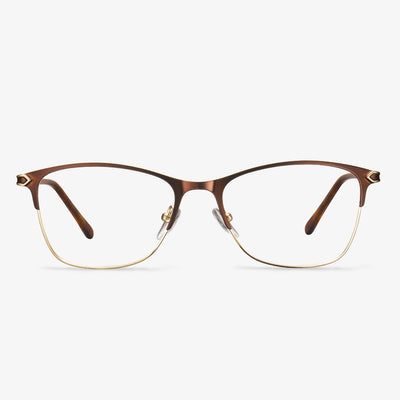What are optical frame glasses?
Optical glasses are transparent medium lenses. A pair of glasses usually consists of a lens, lens ring, nose pad, and temple, etc. The main materials are metal, plastic or resin, natural materials, etc. Through the refraction of the light, the central target can be clearly seen, thus playing a role in vision correction for the eyes with refractive abnormality.
BLUPOND CHOPPER Polarized Driving Sunglasses
It has TAC polarization UV400 high definition lenses and the most progressive anti-glare technology. Increasing street vision, the TAC Polarizing lens is a 7-layer composite system that meets the international UV400 standard. By turning the distorted light into parallel lines, your view will be softer and clearer, making for a more interesting ride. Timeless classic Italian design exudes ingenuity and innovation. A durable frame structure with reinforced hinges gives you a sense of strength and durability, made of the strongest polycarbonate material. It's a fashion statement that's both subtle and sharp.
What is a good progressive lens?
No matter how close the objects you see, the lenses are guaranteed to give you a clear view. Whether it's working with a computer, using a smartphone or tablet screen, or simply reading the newspaper, it's all about bringing a comfortable feeling for you. At the same time, the lenses have greater contrast and clarity. The lenses have been tested and approved by the wearer to ensure customer satisfaction, including quick and easy adaptation.
What color lenses are good for driving?
The optometrist reminded us that it is not advisable to choose pink, purple, light blue, and other colors with obvious decoration effects for driving sunglasses. These colored glasses basically cannot protect the eyes. In addition, they may change the color and cause chromatic aberration. Generally speaking, you should wear brown and gray glasses when driving. The brown lens can filter out a lot of blue light, which can effectively improve visual contrast and clarity. The gray lens can absorb any color spectrum in a balanced manner and will not produce obvious chromatic aberration after wearing.
Nowadays, the colors of lenses for sunglasses on the market are dazzling. Many people only consider whether they look good when choosing colors, and do not pay attention to the impact of lens colors on vision. When choosing sunglasses, we should not only pay attention to their decoration but also pay attention to their protective function for the eyes. We should avoid using blue lenses when driving because it will make us unable to distinguish the color of the traffic signal lights.
Should I wear glasses all the time for myopia?
Whether it is false myopia or true myopia, as long as a pair of suitable myopia glasses are used to complement the missing refractive power of the lens, the image of the object can fall on the retina again, and the distant objects can be seen again. Adolescents usually use high eye intensity and often wear myopia glasses, so that the ciliary muscles do not need to be 'so tired' to adjust, which can avoid further aggravation of pseudomyopia. However, adolescents are still in the process of development, and the degree of true myopia will gradually increase with age. Therefore, as the degree of myopia develops, refraction should be performed at regular intervals, and appropriate glasses for myopia can be prepared to prevent false myopia.
For adults under 200 degrees, because the degree is relatively light, they can wear glasses when they are looking at the distance and not wear glasses when they are near, which has little effect on vision. But for adults with high myopia, because of the weak adjustment ability of the eyes, it is recommended to wear glasses regardless of near vision or distance vision.
In summary, wearing myopia glasses is to reduce eye fatigue and prevents the occurrence of false myopia. Wearing myopia glasses from time to time may aggravate the degree of myopia, and wearing them often does not cause a burden on the eyes. Therefore, for myopia glasses, wearing them frequently is the most correct way to wear them.
Drivers can wear night-vision goggles
Night-vision goggles can prevent headlights from blinding, add color saturation, and make the field of vision clearer. The normal night vision glasses are golden yellow in color and have a metal coating on the surface. This is the use of diamond high perspective reflection film technology, in the lens to add color and film layer, in order to maximize the brightness of the object being seen. It is to compensate for the light for driving, which makes light pass through your eye. It can increase the three-dimensional sense of objects, making the line of sight more clear, to avoid confusion caused by blinding headlights.
Pure titanium glasses
Pure titanium refers to a silver-white transition metal material with a titanium purity of more than 89%. The application of pure titanium as a chemical element to spectacle frames is undoubtedly an improvement and sublimation of spectacle materials. Pure titanium has many disadvantages such as high melting point, lightweight, strong corrosion resistance, metallic luster, firm electroplating layer. Also, titanium metal has beneficial physiological effects on the human body. It is an ecological trace element that is non-toxic and non-radiation to the human body. It has the effects of promoting blood circulation, lowering blood pressure, and relieving stress.











































